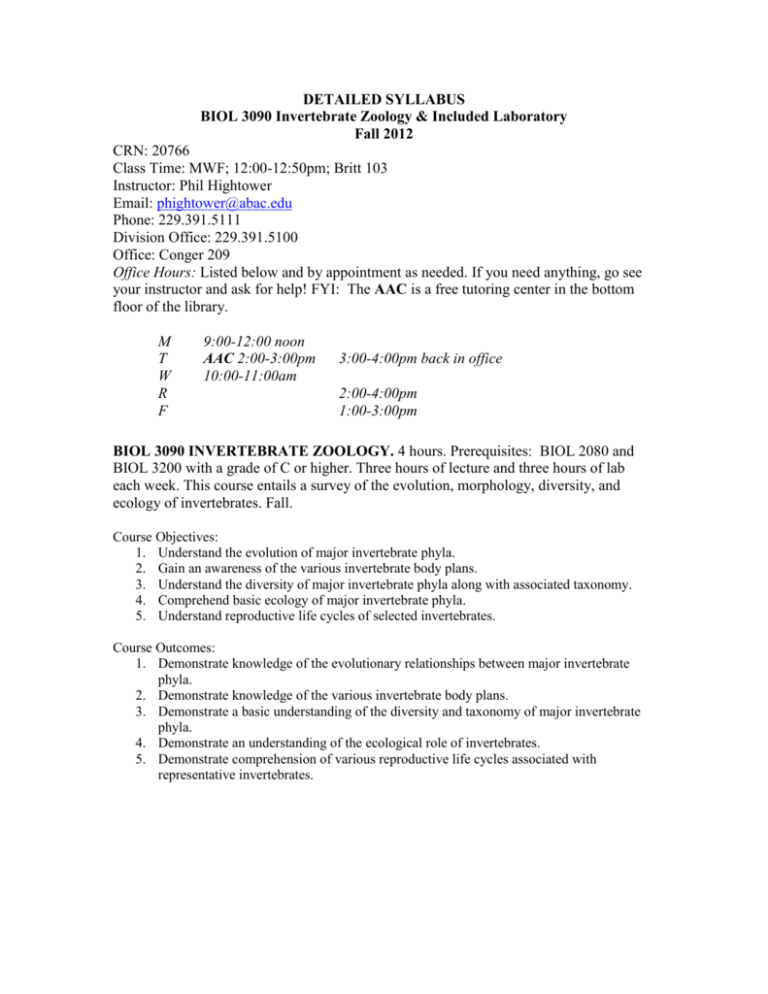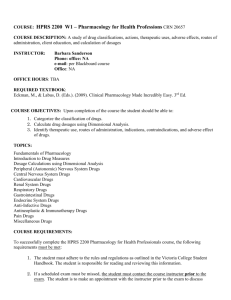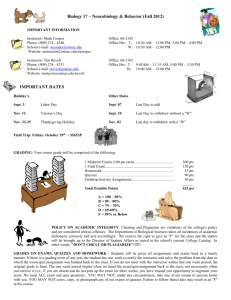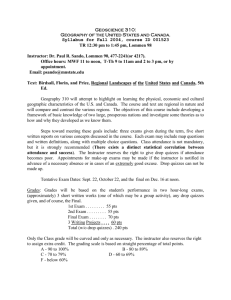detailed syllabus
advertisement

DETAILED SYLLABUS BIOL 3090 Invertebrate Zoology & Included Laboratory Fall 2012 CRN: 20766 Class Time: MWF; 12:00-12:50pm; Britt 103 Instructor: Phil Hightower Email: phightower@abac.edu Phone: 229.391.5111 Division Office: 229.391.5100 Office: Conger 209 Office Hours: Listed below and by appointment as needed. If you need anything, go see your instructor and ask for help! FYI: The AAC is a free tutoring center in the bottom floor of the library. M T W R F 9:00-12:00 noon AAC 2:00-3:00pm 10:00-11:00am 3:00-4:00pm back in office 2:00-4:00pm 1:00-3:00pm BIOL 3090 INVERTEBRATE ZOOLOGY. 4 hours. Prerequisites: BIOL 2080 and BIOL 3200 with a grade of C or higher. Three hours of lecture and three hours of lab each week. This course entails a survey of the evolution, morphology, diversity, and ecology of invertebrates. Fall. Course Objectives: 1. Understand the evolution of major invertebrate phyla. 2. Gain an awareness of the various invertebrate body plans. 3. Understand the diversity of major invertebrate phyla along with associated taxonomy. 4. Comprehend basic ecology of major invertebrate phyla. 5. Understand reproductive life cycles of selected invertebrates. Course Outcomes: 1. Demonstrate knowledge of the evolutionary relationships between major invertebrate phyla. 2. Demonstrate knowledge of the various invertebrate body plans. 3. Demonstrate a basic understanding of the diversity and taxonomy of major invertebrate phyla. 4. Demonstrate an understanding of the ecological role of invertebrates. 5. Demonstrate comprehension of various reproductive life cycles associated with representative invertebrates. LECTURE Portion of the Class TEXTBOOK: Jan A. Pechenik. 2010. Biology of the Invertebrates. 6th edition. McGraw Hill. ATTENDANCE: Regular class attendance is expected. Roll will be taken each class period and generally during the first 10 minutes of class. Any student not present at the time the roll is taken or missing a significant portion of the class will normally be counted absent. Two tardies will count as one absence. Plan to be on time and stay for the full class time. If you are playing on cell phones or devices, it is the instructor's opinion that you are not really present in mind or spirit nor fully attempting to learn the material necessary to be successful in the course. The instructor reserves the right to assign tardies in such cases. Students absent from class due to any non-institutional reasons will usually not be allowed to make up any missed point opportunities (quizzes, exams, in-class assignments, etc.). In addition, the student will lose the opportunity to learn the material in a classroom environment and may miss any announcements regarding exams, quizzes, and assignments. It is each student’s responsibility to keep up with all classroom activities; lecture notes (oral, written on the board, or on slides); and dates of exams, assignments, quizzes, etc. Students missing class due to official ABAC business are required to notify the instructor ahead of time and make arrangements in a manner acceptable to the instructor to ensure they do not miss any course content, assignments, or exams. In an effort to encourage classroom attendance and thus enhance a student’s exposure to the material, the following bonus points (10 maximum pts, see table) will be awarded on a sliding scale to students who have no or limited non-institutional absences at the end of the semester. Be aware of the difference between points and percentage points. The attendance points are not percentage points. Check with the instructor regularly to see your absences. The instructor’s roll is official and will not generally be changed after the day of class. Use the area below to record days you are absent or miss a significant portion of the class and to calculate bonus points. Again, these are points, not percentage points. Dates absent (if any) ___________ ___________ ___________ ___________ ___________ 0 absences = + 10 pts 1 absence = + 8 pts 2 absences = + 6 pts 3 absences = + 4 pts 4 absences = + 2 pts 5 absences or more = + ZERO pts WITHDRAWAL: A student may withdraw from the course up to the midpoint of the semester and receive a grade of W. After midterm, students may withdraw only with the permission of the Academic Dean and may receive a W or WF according to their documented averages at the time of withdrawal. Students abandoning classes will still receive a grade at the end of the semester (probably an F due to missed point opportunities). See the college catalog for the college policy on withdrawal. ACADAMIC RESPONSIBILITY: Cheating and Academic Dishonesty in any way, shape, or form is grounds for an assigned grade of an F, possible dismissal from the course, and perhaps other punitive action depending upon the circumstances. Refer to the college catalog (www.abac.edu/ses/handbook/CodeofConduct.pdf) for a more complete explanation. Be aware that plagiarism is also considered to be academic dishonesty. Feel free to check with the instructor before turning in an assignment if you are unclear on the meaning of plagiarism. Electronic checking for plagiarism may be used in this course. GRADING: Lecture Grades will be determined by dividing the total points you EARN by the total number of points possible. It is estimated that there will be approximately 500 lecture points. Any late assignments accepted will receive a 15% penalty for each ABAC work-day or any part thereof that it is late. Assignments 7 days late or more will receive a zero. Also, be aware that any assignments turned in after the last day of the class will receive a zero. TESTING: There will be four lecture exams over content assigned or discussed during class. The lowest regular lecture exam score will be dropped at the end of the semester. If a student misses one exam, then that will be the lowest grade (0) and will be dropped. Subsequent missed exams will not be able to be dropped. For example, if a student misses two regular lecture exams, one will be dropped and the student will normally receive a ZERO for the other missed exam. Makeup exams are not generally given. If the instructor chooses to allow a makeup exam, then it must be taken within one week of the scheduled exam. The final exam will be comprehensive and will not be able to be dropped. Cell phones, pagers, music players, and any electronic communication device must be turned off during any testing periods. All such items must be on mute/silent at other times and should not be in active use. The wearing of earbuds is prohibited at any time during class, including during exams. Students may not use programmable calculators on inclass exams or quizzes. Students may be asked to remove caps or turn them around during testing periods. CLASS POINTS Paper, assignments, take-home quizzes, and pop quizzes: Total 100pts (Approximate) Exam 1 100pts Exam 2 100pts Exam 3 100pts Exam 4 100pts Total Exam Points 300pts (remember lowest exam grade drops) Comprehensive Final Exam 100pts Total Lecture Points 500 pts (Approximate) Biol 3090 Britt 103 Hightower CRN: 20766 MWF 12:00-12:50pm Tentative Class Schedule Note: The instructor reserves the right to change the schedule at anytime. If the class is officially canceled, plan on the missed day’s activities occurring on the next class day. Monday 8/13 Syllabus, Intro. material from Ch. 1 & 2 8/20 Ch. 3 cont. 8/27 Ch. 4 cont. 9/3 Labor Day-No Class 9/10 Exam 1 (Ch. 1,2,3,4,5,6) 9/17 Ch. 8 cont. 9/24 Ch. 10 cont. Ch. 11 The Nemertines 10/1 Ch. 12 cont. Wednesday 8/15 Intro. material from Ch. 1 & 2 Friday 8/17 Ch. 3 The Protists 8/22 Ch. 3 cont. 8/29 Ch. 4 cont. Paper Abstracts due! 9/5 Ch. 6 cont. 9/12 Ch. 7 The Ctenophores 9/19 Ch. 8 cont. 9/26 Ch. 16 The Nematodes (Lab Practical 1) 10/3 Exam 2 (Ch. 7,8,10,11,16, half 12) 8/24 Ch. 4 Poriferans and Placozoans 8/31 Ch. 5 The Hydrostatic skeleton Ch. 6 The Cnidarians 9/7 Ch. 6 cont. 9/14 Ch. 8 The Platyhelminthes 9/21 Ch. 10 The Gnathifera 9/28 Ch. 12 The Molluscs 10/5 Ch. 12 cont. (Thursday is midterm withdrawal day) 10/8 Ch. 12 cont. 10/15 Fall Break (10/15-16) No class today 10/22 Ch. 14 The Arthropods 10/10 Ch. 13 The Annelids 10/17 Ch. 13 cont. 10/12 Ch. 13 cont. 10/19 TBA 10/24 Ch. 14 cont. 10/29 Ch. 14 cont. 11/5 Ch. 15 Tardigrades and Onychophorans 11/12 Ch. 20 The Echinoderms 10/31 Ch. 14 cont. 11/7 Ch. 19 The Lophophorates and Entopracts 11/14 Ch. 20 cont. (Lab Practical 2) 11/21 Thanksgiving Break Give thanks, no classes! 11/21-23 11/28 Ch. 23 The Nonvertebrate Chordates 10/26 Ch. 14 cont. Paper Draft due! 11/2 Exam 3 (Ch. half 12,13,14) 11/9 Ch. 19 cont. 11/19 Ch. 21 The Hemichordates Paper due! 11/26 Ch. 22 The Xenoturbellids 3090 MWF Mon, 12:30-2:30pm COMPREHENSIVE FINAL Britt103 Lecture Invertebrate Paper (60 pts Total) 11/16 Ch. 20 cont. 11/23 Thanksgiving Break Give thanks, no classes! 11/21-23 11/30 Exam 4 (Ch. 15, 19, 20, 21, 22) Last day of Classes. At part of your lecture grade, you will prepare a paper on an invertebrate species belonging to one of the categories (1-19) below. Once a category has been chosen by a student, it is no longer available to the rest of the class. Choosing order will be determined by lot in class. 1. Phylum Porifera Phylum Cnidaria 2. Class Syphozoa, Cubozoa, or Hydrozoa 3. Class Anthozoa 4. Phylum Ctenophora 5. Phylum Platyhelminthes 6. Phylum Rotifera 7. Phylum Nemertea Phylum Mollusca 8. Class Gastropoda 9. Class Bivalvia 10. Class Cephalopoda 11. Phylum Annelida Phylum Arthropoda Subphylum Chelicerata 12. Class Merastomata 13. Class Arachnida 14. Subphylum Mandibulata Superclass Hexapoda 15. Class Insecta 16. Class Crustacea 17. Phylum Tardigrada 18. Phylum Nematoda 19. Phylum Echinodermata After thoroughly researching your chosen invertebrate species, you will prepare a paper containing the components as detailed below. Read these items carefully and be sure your paper conforms to the standards as you will be graded in part on how well you follow directions. For better and for worse, scientific writing almost always has to follow someone else's (instructor, graduate school, health institution, grant, journals, etc.) parameters. You may as well get used to having some imposed guidance. Title page: The one-page title page should include your name, the title of the paper, the course title, the instructor's name, and the current semester. Table of contents: The table of contents should briefly list the sections of your paper along with their corresponding page numbers. Body of text: The body of the text should contain at a minimum these sections: Introduction, Description and Taxonomy, Life History (reproduction and growth), Ecology (habitat, diet, trophic level, interspecific relationships, importance to environment including humans if applicable), and Conclusion. You should also include sections discussing any other defining characteristics or points you deem necessary to describe, enumerate, or explain the ecology or importance of your invertebrate species. It usually works best to write the introduction and conclusion after the body of the text is complete. -Each section should be clearly labeled in the text. -Each page should be numbered. -Do not put the title on each page or any other header. -The body of the text shall be between 8 and 10 pages of double-spaced material. -Font should be either Cambria, Calibri, Times, or Times New Roman. -Font size should be no larger than 12. -Margin spacing should be no larger than 1" on the top and bottom and 1.25" on the left and right. -Graphics may comprise no more than 10% of the paper. -In text source citations shall be used for any information that is not general knowledge. Follow APA style. (See http://www.library.cornell.edu/resrch/citmanage/apa) Bibliography: The bibliography shall be in APA style and should include all the sources that you cited in the text. Be sure to collect all needed information at you gather resources. Appropriate reference material and minimum requirements: Peer-reviewed scientific journal articles -You must use a minimum of 8 total of which 4 must be primary research articles. Primary research articles present original research (hypothesis or discover based) done by the authors. You are required to submit copies of the abstracts of your 4 primary research articles for verification. Peer-reviewed scientific journal articles that do not present original research can also be used. Examples would include articles that review others' research or that present the views or thoughts of a recognized authority on a particular subject. Books by recognized authorities are also acceptable but do not count towards the minimum of 8 peer-reviewed journal articles. PLAGIARISM IS NOT ACCEPTABLE. If you do it, you can expect to receive a ZERO for this assignment. See "What is plagiarism?" at: http://www.plagiarism.org/plag_article_what_is_plagiarism.html Paper Due Dates: Wednesday 8/29/12: 5pts-Turn in copies of 4 abstracts of primary research articles that you are certain you will use in your paper. Friday 10/26/12: 5pts-Turn in your rough draft for review. Body of text should be at least 3/4 complete. All other components should be in place and up to date. Monday 11/19/12: 50pts-Turn in your completed paper for grading LABORATORY Portion of the Class LAB MANUAL: Wallace and Taylor. 2003. Invertebrate Zoology: A Laboratory Manual. 6th edition. Benjamin Cummings. ATTENDANCE: Roll will be taken each day of lab. Students absent from lab due to any non-institutional reasons will not be allowed to make up any missed point opportunities (quizzes, exams, assignments, etc.). It is each student’s responsibility to keep up with all lab activities; lab notes (spoken aloud, written on the board, or on slides); and dates of exams, assignments, quizzes, etc. Students missing laboratory due to official ABAC business are required to notify the instructor ahead of time and make arrangements in a manner acceptable to the instructor. LAB ASSIGNMENTS AND QUIZZES: There will be lab assignments and lab quizzes throughout the semester estimated to be worth an estimated total of 100 points. TESTING: There will be two Lab Practical Exams, one near midterm and one closer to the end of the semester. Each will be worth 100 pts. Cell phones, pagers, music players, and any electronic communication device must be turned off during any testing periods. All such items must be on mute/silent at other times. The wearing of earbuds is prohibited at any time during lab, including during exams. Students may not use programmable calculators on in-class exams or quizzes. Students may be asked to remove caps or turn them around during testing periods. LAB POINTS Lab activities and quizzes Lab Practical Exam 1 Lab Practical Exam 2 Total Lab Points 100pts (Estimated) 100 pts 100 pts_ 300 pts (Estimated) GRADING: Laboratory Grades will be determined by dividing the total points you earn by the total number of points possible. Tentative Laboratory Schedule FALL 2012 Biol 3090L BRITT 204: W 2:00-4:50pm Date Aug 15 Aug 22 Aug 29 Sept 5 Sept 12 Sept 19 Sept 26 BIOL 3090L Roll Call and Lab Procedures Ex. 1 The Protozoans Ex. 1 cont. Ex. 2 Phylum Porifera Ex. 3 Phylum Cnidaria Ex. 5 Phylum Platyhelminthes Lab Practical Exam 1 (Ex. 1,2,3,5) (Midterm withdrawal day is Thursday Oct 4) Oct 3 Oct 10 Oct 17 Oct 24 Oct 31 Nov 7 Nov 14 Ex. 10 Phylum Mollusca Ex. 10 cont. Ex. 11 Phylum Annelida Ex. 16 Phylum Arthropoda Ex. 16 cont. Ex. 22 Phylum Echinodermata Lab Practical Exam 2 (Ex. 10, 11, 16, 22) Nov 21 Thanksgiving Break Nov 21-23 No Labs This Week! Lab Worksheet on: Ex. 24 Phylum Hemichordata & Ex. 25 Phylum Chordata Nov 28 (Fri., Nov 30, Last Class Day) FINAL COURSE GRADE An assigned final grade for the 4hr course will be determined using the letter/percentages below by combining the percentages from lecture and lab. The lecture grade will count 70% of the final grade and the lab grade will count 30% of the final grade. For example, if you made a 0.79 in class and a 0.83 in the lab; you would figure your grade as (0.79 X 0.70) + (0.83 X 0.30)= (0.553 + 0.249) = 0.802 and thus you would have earned a B for the 4 hour course. A 90-100% B 80-89% C 70-79% D 60-69% F zero-59% If there is a student in this class who has properly documented specific needs because of learning disabilities or any other disability, please feel free to contact the instructor.







